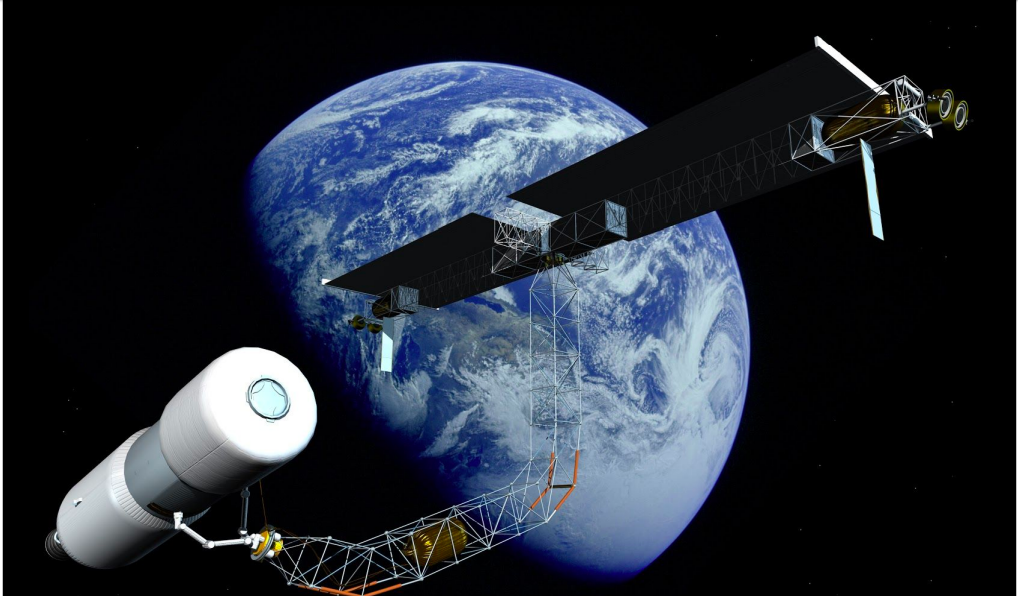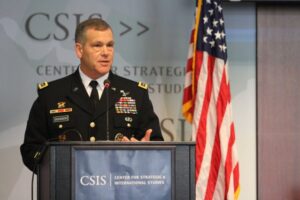
Graphic credit: Skycorp
WASHINGTON: DoD should develop plans to “protect, support, and leverage commerce in space” in future — including establishing logistics capabilities all the way out to the Moon and beyond, recommends a new report spearheaded by the Defense Innovation Unit (DIU).
“Our mission in the Space Force will become to protect that commerce, and I like to talk about it in terms of protecting the ‘celestial lines of commerce,’ or the space lines of commerce,” said Col. Eric Felt, head of the Space Vehicles Directorate at Air Force Research Laboratory (AFRL). Felt spoke at a webinar today hosted by the Center for Strategic and International Studies, rolling out the new “State of the Space Industrial Base 2020” study, co-sponsored by AFRL and the Space Force.
To meet this mission, Felt added, he is looking to focus efforts at AFRL on technologies to enable operations beyond Geosynchronous Orbit (GEO, 36,000 kilometers above the Earth), the maximum altitude for most military and commercial satellites. That means reaching into cislunar space — the region between GEO and the Moon — and out to the orbit of the Moon itself.
“I see a need for technology that is going to enable us to go to the cislunar area above GEO, and how do we operate up there and how do we maintain awareness of what’s going on up there,” he said. “And I see a need for logistical activities. … The further you go away from the Earth, the more you need logistics; and, logistics that are going to make you more resilient in your space capabilities, not more vulnerable in your space capabilities.”
According to the study, such logistics could include mining the Moon and building fueling stations for spacecraft. “Lunar resources, including hydrogen/oxygen for propellant that enable cheaper mobility for civil, commercial and national security applications, are key for access to asteroid resources and Mars, and to enable overall space commercial development,” the study says.
“With a role similar to an Army Corps of Engineers, SeaBees or Coast Guard, the USSF can guide and
accelerate the development of critical infrastructure,” it adds.
The proposed shift in DoD’s space mission to explicitly protect US commercial activities out to cislunar space, as opposed to focusing on protecting US military activities currently on orbit nearer to Earth, echoes an earlier study by the now-defunct Air Force Space Command. That Sept. 5 study, called “The Future of Space 2060 and Implications for U.S. Strategy,” laid out eight possible far-futures for human endeavors in space, and concluded that the US requires a sweeping new strategy that encompasses protection of commercial activities such as resource extraction and US citizens living off-world.
A similar study was released on June 16 by the influential Aerospace Corporation.
“If we look down range, are we doing the things that we need to today to secure the future that we want for America?” Brig. Gen. Bucky Butow, DIU’s Space Portfolio Director, told the webinar. “We should be asking ourselves critically: how do we want the 21st century to end?”
As Breaking D readers know, national security space leaders are more and more preoccupied with cislunar space — seeing it as a future area of global competition, particularly with China. DoD has myriad new efforts aimed at developing technologies to expand military uses of cislunar space, including activities at Air Force Research Laboratory’s Space Vehicles Directorate; DARPA’s nuclear-powered rocket project called Demonstration Rocket for Agile Cislunar Operations (DRACO); and the Space Development Agency’s (albeit financially constrained) interest in developing satellites for space domain awareness capabilities to monitor future activities by potential adversaries (read Chinese) around the Moon.
The recommendations in the DIU report stemmed from a May workshop that brought together more than 120 experts from government, industry and academia to assess the current health of the space industry and recommend how to strengthen it. The report represents the outcome of those discussions.
“While the findings and recommendations from that workshop do not represent the official position of the United States Space Force, or any other branch of the government, it is important that we listen to these insights and evaluate the feasibility of implementing them in the advancement of national interests,” Gen. Jay Raymond wrote in the study’s forward.

Lt. Gen. James Dickinson
Raymond currently heads both the Space Force and Space Command, but he will shortly be giving up the SPACECOM role to his successor, Army Lt. Gen. James Dickinson. In a harmonious confirmation hearing this afternoon, Senate Armed Services chairman James Inhofe in his opening remarks noted there is “no opposition that I know of” to either Dickinson or the nominee to take over Northern Command, Air Force Lt. Gen. Glen D. VanHerck. Dickinson currently serves as SPACECOM deputy.
The six focus areas of the DIU study were:
- Space policy and finance tools to secure US space leadership now and into the future by building
a unity-of-effort and incentivizing the space industrial base - Space information services include space communications/internet, positioning, navigation and
timing (PNT), and the full range of Earth observing functions which have commercial, civil and
military applications. - Space transportation and logistics to, in and from cislunar space and beyond.
- Human presence in space for exploration, space tourism, space manufacturing and resource
extraction. - Power for space systems to enable the full range of emerging space applications.
- Space manufacturing and resource extraction for terrestrial and in space markets.
The report makes six recommendations for the US government to bolster the space industrial base, and four recommendations for industry itself.
The report pushes for a “whole of government” approach to bolstering space industrial development. This should be led by a special Presidential Task Force, it adds. In addition, the report calls for the establishment of a set of financial stimulus measures to help kickstart that development.
Industry, first and foremost, should “aggressively pursue partnerships with the US government to develop and operate joint commercial, civil and defense space capabilities” — including bringing their own research and development funds.
“Entrepreneurs with innovative and potentially dual-use technologies must improve the protection of their intellectual property from unintended foreign assimilation, including protecting their networks from cyber exfiltration attempts, and avoiding exit strategies that transfer intellectual property to foreign control hostile to US interests,” the study adds.
In a ‘world first,’ DARPA project demonstrates AI dogfighting in real jet
“The potential for machine learning in aviation, whether military or civil, is enormous,” said Air Force Col. James Valpiani. “And these fundamental questions of how do we do it, how do we do it safely, how do we train them, are the questions that we are trying to get after.”


























